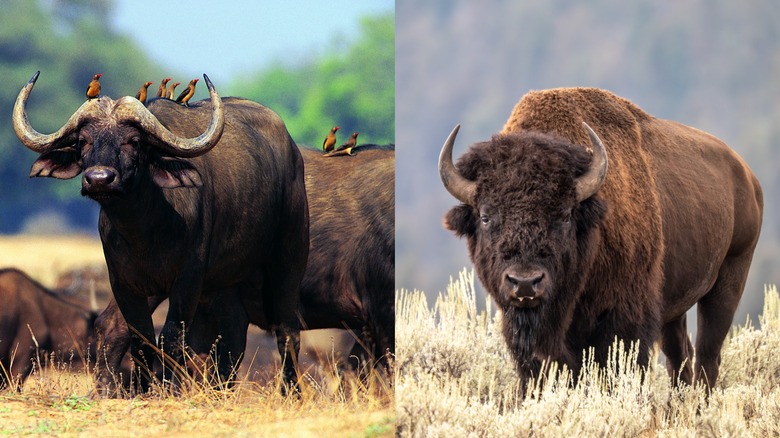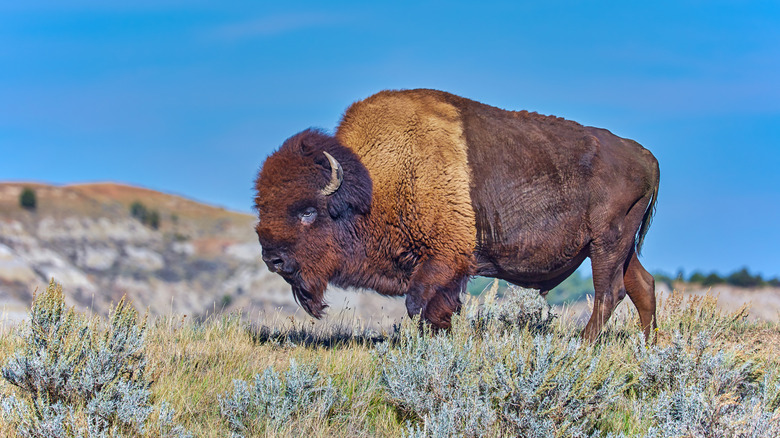If You Thought Buffalo And Bison Were The Same Thing, You'd Be Dead Wrong
Buffalo are an icon of the American wild. They have been honored in song ("Home on the Range"), athletic teams (the University of Colorado Buffaloes), famous people (Buffalo Bill Cody), entire cities (Bufalo, New York), and even one of the United States' only native grasses (Buffalo grass). All of these references are rooted in a falsehood. The Great Plains is not the home where the buffalo roam. The majestic creatures honored in American culture are, in fact, bison, and not only are they not true buffalo, but they are hardly even related to them.
True buffalo are not found anywhere in the Western Hemisphere outside of zoos. Instead, they are native to Africa and Asia. They are distantly related to bison; both are bovids, members of the family Bovidae along with cows, goats, sheep, and antelope. However, they are only distantly related. Their last common ancestor lived long ago; in fact, bison are more closely related to cows than they are to real buffalo.
How did two animals, distantly related and separated by entire continents, become confused with one another? The blame lies with French explorers in the early 1600s, who referred to bison as "boeuf sauvage," boeuf being a word broadly used to reference ox-like animals, including true buffalo. The word "buffalo" came about as an English adaptation of "beouf". The word bison didn't come around until decades later, finally giving a proper label to the species.
What are true buffalo?
"True buffalo" is a broad term used to refer to three different species within the bovine subtribe Bubalina. First, there is the water buffalo, also known as the Asian buffalo (Bubalus bubalis), whose native territory ranges from the Indian subcontinent to the Malay Peninsula. Water buffalo were domesticated around 6,000 years ago for agricultural purposes, and humans have since introduced them to every continent with the exception of Antarctica. Many researchers now consider wild water buffalo to be a different species (Bubalus arnee). The wild ones can reach 10 feet in length and weigh 2,600 pounds, making them even larger than most bison.
Next, there are African buffalo (Syncerus caffer), which are divided into four subspecies. The largest and most common is the cape buffalo, which, despite barely reaching 5 feet in height, can weigh close to 2,000 pounds. They are joined by the smaller subspecies of forest buffalo, Central African buffalo, and West African savannah buffalo. Buffalo, along with lions, leopards, elephants, and rhinoceroses, are considered one of Africa's "big five." Originally a term used by hunters to reference the most dangerous game animals, the "big five" label is now used by safari tours.
Finally, there are the anoa. The smallest of all buffalo, they stand just two and a half feet tall. There are two species, the mountain anoa (Bubalus quarlesi) and lowland anoa (Bubalus depressicornis). Both species are endangered, with their wild populations estimated at around just 2,500 individuals each.
There are actually two species of bison
The American bison (Bison bison), is the largest native land animal in the United States, and the country's official national mammal. In reality, they bear only a passing resemblance to true buffalo. Bison have bulkier bodies, with massive heads and humped backs. Living in a colder, drier climate than African or Asian buffalo, bison keep warm with an extra-thick layer of fur that they shed annually in warm weather. Bison horns are also much different from those of true buffalo, being sharper, shorter, and more upright.
Bison played a central role for the indigenous people of the Great Plains, who utilized every part of the animal for purposes ranging from food to clothing to tools made from horns. However, the influx of white settlers in the American West resulted in the near total extinction of bison. Populations plummeted from over 50 million to less than 1,000 by the end of the 19th century. Conservation efforts have helped to grow the bison population, but there are still only around 30,000 living in the wild.
There is a second, lesser-known species of bison: the European bison (Bison bonasus). It is leaner than the American bison, with longer legs befitting the forested environments it favors. Once widespread across Europe, their population began to drop after the last Ice Age due to aggressive hunting by humans, and by the 1900s, the only surviving members of the species were in zoos. Since then, breeding programs have helped revitalize the wild population.


